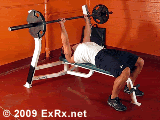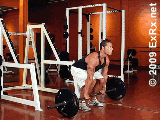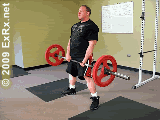A disclaimer: Though powerlifting is more popular amongst men, it is becoming increasingly popular amongst women, which is awesome. Still, I use the generic "he" to refer to the lifter without respect to sex. Yeah, I know that's not politically correct, but I don't care. It makes the text cleaner than if I were to constantly say "his or her." Besides, "there was rather a rather extended period of time in the history of the English language when the choice of a supposedly masculine personal pronoun (him) said nothing about the gender or sex of the referent" (Susanne Wagner, Gender in English Pronouns: Myth and Reality, PhD thesis, Albert Ludwigs Universität, 2003. Page 41).
Distinct from weightlifting, a sport made up of two lifts: the Snatch and the Clean-and-Jerk, where the weight is lifted above the head, powerlifting comprises three lifts: the Squat, Bench Press and Deadlift. Powerlifting competitions may be comprised of one, two or all three of the lifting disciplines. Athletes are categorized by sex, age and bodyweight. Each competitor is allowed three attempts at each lift, the best lift in each discipline being added to their total. The lifter with the highest total is the winner. In cases where two or more lifters achieve the same total, the person with the lightest bodyweight wins.
In the Olympics you see competitors perform two lifts: the Clean & Jerk, and the Snatch. I'm not interested in those. Instead, in a powerlifting competition contestants perform these three simple lifts:
THE SQUAT

Once given approval by the judge, the lifter must descend until the hip flexors--basically the top of the leg just under the abdominal muscles--are lower than the knee. If the lifter does not squat deeply enough, the lift won't count. Once he feels he has descended deeply enough, he pushes up until he is standing erect again. If the barbell does not ascend continuously (even if very slowly), the lift won't count.
At the completion of the squat, the lift isn't over! Now, the lifter must again demonstrate control under the weight on his back until the judge gives approval to rack the barbell. Fortunately, at that point the spotters can help rack the weight.
THE BENCH PRESS

Upon being given approval to descend, the lifter must lower the barbell until it touches his chest. Unfortunately, he cannot immediately begin the upward movement. The bar must first come to a full stop on his chest; the judge will wait until all movement of any sort ceases before giving approval to lift. This means that if the bar is wobbly, the lifter may have to wait a few seconds before pressing up. The longer the lifter has to wait in this position, the more difficult the upward movement will be.
Once allowed to by the judge, the lifter presses upward until his arms are locked. Again, there must be continuous upward movement, even if very slowly. Any downward movement or clear stops will cause the lift to be invalid. And at the completion of the lift, the lifter must again demonstrate control under the bar before allowed to rack the barbell (again, fortunately the spotter can help at this point).
THE DEADLIFT


JUDGING
A powerlifter is given three attempts per lift. The heaviest successful attempt for any given lift is the one that counts toward the total, but at least one attempt must be successful to qualify. There are three judges, one on each side and one in front (near the lifter's head in the case of the bench press). For an attempt to be successful, at least two judges must approve of the lift. If a judge does not approve of an attempt, he will indicate by holding up a card what error was made by the lifter. Here is an example of what results might look like--the numbers are based on actual YMCA Summer Classic results:
| Name | Wt. Cls. | Sqt 1 | Sqt 2 | Sqt 3 | Bnch 1 | Bnch 2 | Bnch 3 | Ddlft 1 | Ddlft 2 | Ddlft 3 | Total |
| John Doe | 110 | 247.5 | 257.5 | 257.5 | 160 | 167.5 | 170 | 250 | 262.5 | 270 | 687.5 |
| Joe Smith | 125 | 205 | 215 | 110 | 125 | 127.5 | 205 | 227.5 | 235 | 577.5 | |
| Jack Jones | UNL | 227.5 | 237.5 | 127.5 | 132.5 | 137.5 | 250 | 265 | 265 | 625.0 |
Let's walk through each competitor's results in this example. First, John Doe is in the 110 kg (kilogram) weight class. That means he weighs between 100 and 110 kg, or between 220 and 242 lbs (approximated by multiplying kg by 2.2 to get lbs). His first attempt at the squat was successful at 247.5 kg, or 544.5 lbs. He attempted 257.5 kg, or 566.6 lbs, twice, but was unsuccessful both times. His first attempt at the bench press was successful at 160 kg, or 352 lbs. His second attempt at 167.5 kg, or 368.5 lbs, was unsuccessful, but his third attempt at 170 kg, or 374 lbs., was a success. Finally, each of his attempts at the deadlift were successful: first at 250 kg, or 550 lbs.; second at 262.5 kg, or 577.5 lbs.; and third at 270 kg, or 594 lbs.! His total, then, taking his best successful attempt at each lift, was 687.5 kg, or 1512.5 lbs.!
Joe Smith is heavier than John Doe, competing in the 125 kg weight class, weighing between 110 and 125 kg, or between 242 and 275 lbs. His first and second attempts at the squat were successful, at 205 kg and 215 kg, or 451 lbs. and 473 lbs., respectively. He did not attempt it a third time. Each of his three attempts at the bench press were successful, at 110, 125 and 127.5 kg, or 242, 275 and 280.5 lbs., respectively. Likewise, each of his three deadlift attempts were successful, at 205, 227.5 and 235 kg, or 451, 500.5 and 517 lbs., respectively. His total was 577.5 kg, or 1270.5 lbs.
Jack Jones is heavier than either Doe or Smith, weighing over 125 kg, or 275 lbs. There is no maximum to this weight class, hence its lable, "Unlimited." Like Smith, he did not attempt the squat a third time, but unlike Smith he failed his second and third attempts at the deadlift. Nevertheless, his total was enough to beat Smith at 625 kg, or 1375 lbs. Unfortunately, he was unable to defeat the lighter Doe.
OTHER CONSIDERATIONS
Lifters are classified by sex, weight and age; only weight class was distinguished in the example above. Although Jack Jones did not lift as great a total as John Doe, it might have been that Doe was in the "Open" category, being between 25 and 35 years of age, whereas Jones was in one of the "Masters" categories, being older than 35.
Additionally, lifters can compete "raw" or "equipped." Lifting "raw" means you are not wearing certain gear that gives a competitive advantage; squat suits and bench press shirts can add a lot of weight to a lifter's max by compressing the appropriate muscle group. John Smith did more poorly than either of his competitors in the example above. However, it is possible that he competed raw and that his competitors lifted equipped, in which case his lighter lifts are arguably more impressive, since he did not have the benefit of max-increasing gear.

